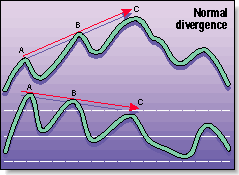
An oscillator's failure to confirm the higher high or the lower low of the market is a red flag to most technical traders. Is there a message when the price diverges from the indicator? This veteran technician thinks there is.
Technical analysts are constantly comparing prices and indicators to see whether they are moving in gear or if there are discrepancies. It's when discrepancies appear that an alert to a probable change in trend is given. Most traders are familiar with the concept of momentum indicators experiencing positive and negative divergences with price. For instance, as you can see in Figure 1, momentum makes a series of declining peaks as the price works its way higher. This indicates that the underlying momentum is gradually dissipating, signaling that a peak in the price may be at hand. The opposite set of conditions would be true for a declining trend. The problem with divergences is that you never know how many to expect prior to the actual trend reversal. An unusual but normally reliable discrepancy occurs when price and momentum switch roles (where the price leads the momentum indicator), the opposite of the normal situation just described. That's why I refer to this phenomenon as a reverse divergence. Figure 2 shows a reverse divergence at a market peak. See how the price makes its high at point A, then makes a lower high at point B, but the oscillator makes a higher high at B. The fact that the oscillator peaks at B as the price is declining is what makes this a reverse divergence.

FIGURE 1: NORMAL DIVERGENCE AND PRICE. Momentum makes a series of declining peaks (lower plotline) as the price (upper plotline) works its way higher. This divergence indicates that the underlying momentum is gradually dissipating, signaling that a peak in the price may be at hand. The opposite set of conditions would be true for a declining trend.
Since the price is determined by the interaction of many different time cycles, it's important to plot several momentum indicators with differing time spans for any given situation.